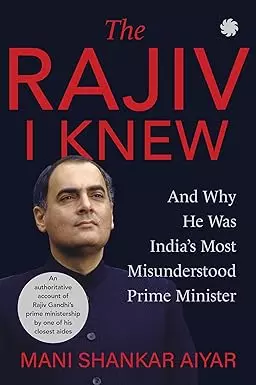Book Review | Aiyar’s Rajiv proves that there’s no one way to judge a dynast
A meticulous exploration of Rajiv Gandhi's tenure, revealing controversies, achievements, and the man behind the Prime Minister

This book appears to be part memoir, part biography. It imparts the flavour of both but, in fact, may be neither. This is because it is written with uncommon zeal. Perhaps the book may not have come about, at least not in its present form, if Prime Minister Rajiv Gandhi had not been hounded by political opponents and the media on the Bofors affair with insufficient care for the facts and an addiction to hypotheses in order to establish pre-determined end results — as Aiyar shows convincingly.
Indeed, the Bofors case occupies a substantial chunk of the writing. Long after his assassination, the former Prime Minister was judicially completely cleared, first by the Delhi high court and eventually the Supreme Court in 2018 when the Narendra Modi government took the matter there. If journalism — at least in its upper reaches — is or ought to be something about setting the record straight, it can only be said that the media remained mealy-mouthed when the courts showed it had barked up the wrong tree in the Bofors case.
In establishing the facts in Bofors — but also in respect of the string of controversies that dogged Rajiv Gandhi as Prime Minister and dragged him down politically — Aiyar appears to have found his cause to serve. And so well has he done so that this book would serve as a tract of history, so meticulous is the documentation and the citation — not a court historian’s outpourings as far as Bofors (and the Shah Bano affair) go.
As for the rest, Aiyar gives the then Prime Minister too much leeway. Without doubt, Rajiv Gandhi is the noblest Prime Minister we have had (not just the most charming and affable), and upstanding. He was also far-sighted. Through strong panchayati raj legislation — in the crafting of which and in whose promotion the author played a stalwart part as an aide to the Prime Minister — and the Technology Missions he fathered, Gandhi has left a lasting contribution, considering he was around for only five years as leader of government, with most of the period embroiled in controversy, as this book details.
But he was inept in understanding the sources of power, and the unseemly uses to which power can be put if permitted to go unchecked or unsupervised. Rajiv Gandhi came to be Prime Minister not through natural selection among competing politicians. He had sharp grasp of India’s past, of the foundational nature of values such as secularism in light of the country’s make-up, a desire to end insurgency situations through dialogue, and in general to do good. But he came unprepared for his role as Prime Minister.
Since he did not come from the pool of politics and was not an instinctive judge of the timbre and tempo of events, Rajiv Gandhi placed too much faith in friends (Arun Singh) and some near relations (Arun Nehru), who sought to fool him, and to disobey the Prime Minister. On Bofors, they both let him down badly.
Along with Singh, then minister of state for defence, Gen. K.S. Sundarji, the Army chief, countermanded the PM’s instructions and nearly brought upon war with Pakistan when the PM was trying to work toward peace. But Gandhi did not make an example of them. He merely — course-corrected. In the Ayodhya case, Arun Nehru hoodwinked the PM totally and was found out only when the damage was done.
Aiyar quotes from the memoirs of J.N. Dixit, a one-time high commissioner to Sri Lanka, former foreign secretary and the country’s first national security adviser, to explicitly say that the whole diplomatic, intelligence advice to intervene in Sri Lanka militarily was misguided. But the author cannot rest his case on this. What about the PM’s own political acumen?
“I also felt that I should stand up for him…” says the author in the Introduction. This is the mark of a good man, not a carpetbagger, of which he might otherwise be accused since he perhaps got his job on account of old school ties with the PM.
In a speech of May 3, 1989, Aiyar quotes the then PM as asserting that India can only survive as a secular country. In fact, this is a value for which Aiyar would himself stand or fall. As this review goes to press, he, along with his daughter Suranya, are being sought to be pilloried by the anti-secular ecosystem of our current era — for standing up to be counted for what they believe in.
The book under review is likely to attract readers since Aiyar is billed in the media as “a Congress leader”, which he is manifestly not. But it should be read anyway for bringing back to us an important phase in the passage of modern India with meticulous documentation. A word on the evidently hurried publication process. A glaring goof-up on the date of signing of the Bofors contract (page 117 — and elsewhere) can confuse readers. The Rajiv Gandhi period is important in the story of the modernising of India in a variety of ways, and in understanding the ways of the conduct of politics by leaders of different shades. So far, it has not been covered in any meaningful way. There are more ways than one to judge a dynast. Aiyar’s book fills an important gap.
The Rajiv I Knew
Mani Shankar Aiyar
Juggernaut Books
pp. 323; Rs 799

